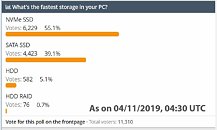- Joined
- Oct 9, 2007
- Messages
- 47,853 (7.38/day)
- Location
- Dublin, Ireland
| System Name | RBMK-1000 |
|---|---|
| Processor | AMD Ryzen 7 5700G |
| Motherboard | Gigabyte B550 AORUS Elite V2 |
| Cooling | DeepCool Gammax L240 V2 |
| Memory | 2x 16GB DDR4-3200 |
| Video Card(s) | Galax RTX 4070 Ti EX |
| Storage | Samsung 990 1TB |
| Display(s) | BenQ 1440p 60 Hz 27-inch |
| Case | Corsair Carbide 100R |
| Audio Device(s) | ASUS SupremeFX S1220A |
| Power Supply | Cooler Master MWE Gold 650W |
| Mouse | ASUS ROG Strix Impact |
| Keyboard | Gamdias Hermes E2 |
| Software | Windows 11 Pro |
Early October, we asked our readers what's the fastest persistent storage device on their computer. Over 11,000 entries and close to 4 weeks into the poll we are calling a winner - NVMe SSD. Over 55 percent or 6,229 of the respondents at the time of this writing chose NVMe SSD. Conventional SATA SSDs, which we felt would to win this poll, comes in second, at 39.1 percent, or 4,423 respondents. Hard drives - either standalone or in RAID setups, added up to a negligible 5.8 percent. This doesn't mean that only 5.8 percent of the respondents have an HDD or HDD RAID, it only means that HDD/HDD RAID is the fastest storage device of only 5.8 percent of the respondents.
The poll results establish that the vast majority of our target audience (the PC gaming and overclocking crowd) is aware of the benefits of flash-based storage, with 94.2 percent responding that they use some kind of SSD. NVMe coming up on top is a surprise. NVMe drives typically offer at least 1 GB/s of transfer-rates (typical of PCIe x2 drives), and their rated transfer-rates can exceed 3 GB/s in short bursts. Besides bring faster, NVMe SSDs in the M.2 form-factor contribute greatly to aesthetics as they lack cables. It's only in the past 18 months that prices of NVMe SSDs are dropping to under $0.25/GB, or what performance-segment SATA SSDs commanded in the years prior.

View at TechPowerUp Main Site
The poll results establish that the vast majority of our target audience (the PC gaming and overclocking crowd) is aware of the benefits of flash-based storage, with 94.2 percent responding that they use some kind of SSD. NVMe coming up on top is a surprise. NVMe drives typically offer at least 1 GB/s of transfer-rates (typical of PCIe x2 drives), and their rated transfer-rates can exceed 3 GB/s in short bursts. Besides bring faster, NVMe SSDs in the M.2 form-factor contribute greatly to aesthetics as they lack cables. It's only in the past 18 months that prices of NVMe SSDs are dropping to under $0.25/GB, or what performance-segment SATA SSDs commanded in the years prior.

View at TechPowerUp Main Site






